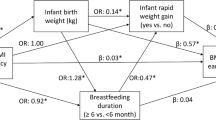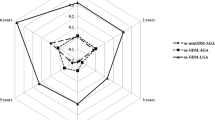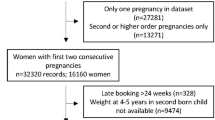Abstract
Objectives
To evaluate the associations of maternal prepregnancy body mass index (pp-BMI) and gestational weight gain (GWG) with the childhood BMI z-score (BMI-z) trajectories from birth to 2 years old and the risk of overweight/obesity (OWO) at 2 years of age.
Subjects/methods
Mother–child dyads (23,617) were involved in the analysis. They were followed up from early pregnancy to 2 years postpartum with their healthcare data recorded in the Wuhan Maternal and Child Health Management Information System (WMCHMIS). The OWO in children was defined as BMI-z > 1. Linear mixed models (LMM) and unconditional logistic regression were used to evaluate the independent and joint associations of pp-BMI and GWG with the BMI-z trajectory of children per their anthropometric measurements at 0, 1, 3, 6, 9, 12, 18, and 24 months old and the risk of OWO at 2 years of age.
Results
Maternal overweight/obesity and excessive GWG independently and jointly increased the risks of their offspring falling into high BMI-z trajectories of birth to 2 years (p < 0.001). In addition, the children whose mothers were overweight/obese before pregnancy and gained excessive weight during pregnancy independently and jointly increased the OWO risk in children at age 2, with adjusted odds ratios (adjOR) of 1.36 (95% CI, 1.22–1.53), 1.28 (95% CI, 1.18–1.39), and 1.76 (95% CI: 1.52–2.03), respectively.
Conclusions
Maternal prepregnancy overweight/obesity and excessive GWG can independently and jointly increase the risks of their children falling into high BMI-z trajectories from birth to 2 years of age and becoming overweight/obese at age 2. Maternal overweight/obesity and excessive gestational weight should be the prime targets for early obese prevention efforts.
This is a preview of subscription content, access via your institution
Access options
Subscribe to this journal
Receive 12 print issues and online access
$259.00 per year
only $21.58 per issue
Buy this article
- Purchase on Springer Link
- Instant access to full article PDF
Prices may be subject to local taxes which are calculated during checkout

Similar content being viewed by others
References
Keß A, Spielau U, Beger C, Gausche R, Vogel M, Lipek T, et al. Further stabilization and even decrease in the prevalence rates of overweight and obesity in German children and adolescents from 2005 to 2015: a cross-sectional and trend analysis. Public Health Nutr. 2017;20:3075–83.
Flores M, Simonsen SE, Manuck TA, Dyer JM, Turok DK. The “Latina epidemiologic paradox”: contrasting patterns of adverse birth outcomes in U.S.-born and foreign-born Latinas. Women’s Health Issues. 2012;22:e501–7.
Ma G. China child obesity report. Beijing: people’s medical publishing house. 2017; p 14.
Llewellyn A, Simmonds M, Owen CG, Woolacott N. Childhood obesity as a predictor of morbidity in adulthood: a systematic review and meta-analysis. Obes Rev. 2016;17:56–67.
Ward ZJ, Long MW, Resch SC, Giles CM, Cradock AL, Gortmaker SL. Simulation of growth trajectories of childhood obesity into adulthood. N Engl J Med. 2017;377:2145–53.
Geserick M, Vogel M, Gausche R, Lipek T, Spielau U, Keller E, et al. Acceleration of BMI in early childhood and risk of sustained obesity. N Engl J Med. 2018;379:1303–12.
Twig G, Yaniv G, Levine H, Leiba A, Goldberger N, Derazne E, et al. Body-mass index in 2.3 million adolescents and cardiovascular death in adulthood. N Engl J Med. 2016;374:2430–40.
Kumar S, Kelly AS. Review of childhood obesity: from epidemiology, etiology, and comorbidities to clinical assessment and treatment. Mayo Clin Proc. 2017;92:251–65.
Voerman E, Santos S, Golab BP, Amiano P, Jaddoe VWV. Maternal body mass index, gestational weight gain, and the risk of overweight and obesity across childhood: an individual participant data meta-analysis. PLoS Med. 2019;16:e1002744.
Sridhar SB, Darbinian J, Ehrlich SF, Markman MA, Gunderson EP, Ferrara A, et al. Maternal gestational weight gain and offspring risk for childhood overweight or obesity. Am J Obstet Gynecol. 2014;211:259.e1–2598.
Wrotniak BH, Shults J, Butts S, Stettler N. Gestational weight gain and risk of overweight in the offspring at age 7 y in a multicenter, multiethnic cohort study. Am J Clin Nutr. 2008;87:1818–24.
Aris IM, Chen LW, Tint MT, Pang WW, Soh SE, Saw SM, et al. Body mass index trajectories in the first two years and subsequent childhood cardio-metabolic outcomes: a prospective multi-ethnic Asian cohort study. Sci Rep. 2017;7:8424.
Buscot MJ, Thomson RJ, Juonala M, Sabin MA, Burgner DP, Lehtimäki T, et al. BMI trajectories associated with resolution of elevated youth BMI and incident adult obesity. Pediatrics. 2018;141:e20172003.
Roy SM, Chesi A, Mentch F, Xiao R, Chiavacci R, Mitchell JA, et al. Body mass index (BMI) trajectories in infancy differ by population ancestry and may presage disparities in early childhood obesity. J Clin Endocrinol Metab. 2015;100:1551–60.
Montazeri P, Vrijheid M, Martinez D, Basterrechea M, Fernandez‐Somoano A, Guxens M, et al. Maternal metabolic health parameters during pregnancy in relation to early childhood BMI trajectories. Obesity. 2018;26:588–96.
Hu Z, Tylavsky FA, Han JC, Kocak M, Fowke JH, Davis R, et al. Maternal metabolic factors during pregnancy predict early childhood growth trajectories and obesity risk: the CANDLE Study. Int J Obes. 2019;43:1914–22.
Yang S, Peng A, Sheng W, Jing W, Zhao J, Zhang Y, et al. Pre-pregnancy body mass index, gestational weight gain, and birth weight: a cohort study in China. PLoS ONE. 2015;10:e0130101.
Chen CM. Overview of obesity in Mainland China. Obes Rev. 2008;9:14–21.
Institute of Medicine. Weight Gain During Pregnancy: Reexamining the Guidelines. Washington: National Academies Press. 2009; p 2.
Baumgartner J, Smuts CM, Aeberli I, Malan L, Tjalsma H, Zimmermann MB. Overweight impairs efficacy of iron supplementation in iron-deficient South African children: a randomized controlled intervention. Int J Obes. 2013;37:24–30.
Yang S, Mei H, Mei H, Yang Y, Li N, Tan Y, et al. Risks of maternal pre-pregnancy overweight/obesity, excessive gestational weight gain, and bottle-feeding in infancy rapid weight gain: evidence from a cohort study in China. Sci China Life Sci. 2019;62:1580–9.
Liu P, Xu L, Wang Y, Zhang Y, Du Y, Sun Y, et al. Association between perinatal outcomes and maternal pre-pregnancy body mass index. Obes Rev. 2016;17:1091–102.
Flegal KM, Carroll MD, Kit BK, Ogden CL. Prevalence of obesity and trends in the distribution of body mass index among US adults, 1999–2010. JAMA. 2012;307:491–7.
Catalano PM, Shankar K. Obesity and pregnancy: mechanisms of short term and long term adverse consequences for mother and child. BMJ. 2017;356:j1.
Deputy NP, Sharma AJ, Kim SY, Hinkle SN. Prevalence and characteristics associated with gestational weight gain adequacy. Obstet Gynecol. 2015;125:773–81.
Liu J, Gallagher AE, Carta CM, Torres ME, Moran R, Wilcox S. Racial differences in gestational weight gain and pregnancy-related hypertension. Ann Epidemiol. 2014;24:441–7.
Gaillard R, Santos S, Duijts L, Felix JF. Childhood health consequences of maternal obesity during pregnancy: a narrative review. Ann Nutr Metab. 2016;69:171–80.
Godfrey KM, Reynolds RM, Prescott SL, Nyirenda M, Jaddoe VWV, Eriksson JG, et al. Influence of maternal obesity on the long-term health of offspring. Lancet Diabetes Endocrinol. 2017;5:53–64.
Maes HH, Neale MC, Eaves LJ. Genetic and environmental factors in relative body weight and human adiposity. Behav Genet. 1997;27:325–51.
Poston L. Maternal obesity, gestational weight gain and diet as determinants of offspring long term health. Best Pr Res Clin Endocrinol Metab. 2012;26:627–39.
Ruager-Martin R, Hyde MJ, Modi N. Maternal obesity and infant outcomes. Early Hum Dev. 2010;86:715–22.
Reynolds RM. Childhood obesity: the impact of maternal obesity on childhood obesity. Berlin, Heidelberg: Springer; 2011.
Robinson SM, Godfrey KM. Feeding practices in pregnancy and infancy: relationship with the development of overweight and obesity in childhood. Int J Obes. 2008;32:S4–10.
Scaglioni S, Arrizza C, Vecchi F, Tedeschi S. Determinants of children’s eating behavior. Am J Clin Nutr. 2011;94:2006S–11S.
Meyer DM, Brei C, Stecher L, Much D, Brunner S, Hauner H. Leptin in maternal plasma and cord blood as a predictor of offspring adiposity at 5 years: a follow-up study. Obesity. 2018;26:279–83.
Penfold NC, Ozanne SE. Developmental programming by maternal obesity in 2015: Outcomes, mechanisms, and potential interventions. Horm Behav. 2015;76:143–52.
Masuyama H, Hiramatsu Y. Effects of a high-fat diet exposure in utero on the metabolic syndrome-like phenomenon in mouse offspring through epigenetic changes in adipocytokine gene expression. Endocrinology. 2012;153:2823–30.
Mühlhäusler BS. Programming of the appetite-regulating neural network: a link between maternal overnutrition and the programming of obesity? J Neuroendocrinol. 2007;19:67–72.
Seal N, Broome ME. Prepregnancy body mass index and feeding practices in relation to infants’ growth. J Nurse Pract. 2013;9:10.
Farajian P, Panagiotakos DB, Risvas G, Malisova O, Zampelas A. Hierarchical analysis of dietary, lifestyle and family environment risk factors for childhood obesity: the GRECO study. Eur J Clin Nutr. 2014;68:1107–12.
Nelson SM, Matthews P, Poston L. Maternal metabolism and obesity: modifiable determinants of pregnancy outcome. Hum Reprod Update. 2010;16:255–75.
Karachaliou M, Georgiou V, Roumeliotaki T, Chalkiadaki G, Daraki V, Koinaki S, et al. Association of trimester-specific gestational weight gain with fetal growth, offspring obesity, and cardiometabolic traits in early childhood. Am J Obstet Gynecol. 2015;212:502.e1–14.
Bider-Canfield Z, Martinez MP, Wang X, Yu W, Bautista MP, Brookey J, et al. Maternal obesity, gestational diabetes, breastfeeding and childhood overweight at age 2 years. Pediatr Obes. 2017;12:171–8.
Robinson SM, Crozier SR, Harvey NC, Barton BD, Law CM, Godfrey KM, et al. Modifiable early-life risk factors for childhood adiposity and overweight: an analysis of their combined impact and potential for prevention. Am J Clin Nutr. 2015;101:368–75.
Acknowledgements
We extend our sincere thanks to the healthcare staff from the Wuhan Maternal and Child Healthcare Hospital that provided support for data collection. We also greatly appreciate the participants included in this study.
Author information
Authors and Affiliations
Contributions
RX Chang design the research, interpreted the results, contributed to the discussions, wrote of the manuscript. YY Zhang collected and analyzed the data, revised the manuscript. All authors have reviewed the manuscript and approved the final submitted for publication.
Corresponding authors
Ethics declarations
Competing interests
The authors declare no competing interests.
Ethical approval
This study was approved by the Ethics Committee of Wuhan Children’s Hospital (Wuhan Maternal and Child Healthcare Hospital), Tongji Medical College, and Huazhong University of Science and Technology (No. 2020R025-E01).
Additional information
Publisher’s note Springer Nature remains neutral with regard to jurisdictional claims in published maps and institutional affiliations.
Supplementary information
Rights and permissions
About this article
Cite this article
Chang, R., Mei, H., Zhang, Y. et al. Early childhood body mass index trajectory and overweight/obesity risk differed by maternal weight status. Eur J Clin Nutr 76, 450–455 (2022). https://doi.org/10.1038/s41430-021-00975-6
Received:
Revised:
Accepted:
Published:
Issue Date:
DOI: https://doi.org/10.1038/s41430-021-00975-6
This article is cited by
-
Maternal weight and its association with risk of overweight in offspring: a trajectory analysis from a birth cohort in China
World Journal of Pediatrics (2023)
-
The Uterine Environment and Childhood Obesity Risk: Mechanisms and Predictions
Current Nutrition Reports (2023)



